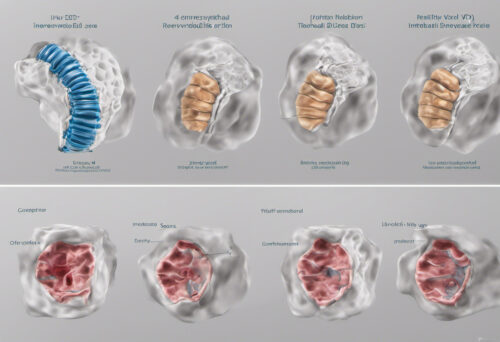Did you know that Intervertebral Disc Disease (IVDD) is a common ailment experienced by many dogs, particularly those with long backs and short legs such as the Dachshund or the Basset Hound? Not to worry, though – with the right understanding and care, you can help your furry friend steer clear of major discomfort and health complications. We’ve delved into the nitty-gritty of this disease and broken down its nature and some effective treatment options for you.
The Nitty-Gritty of IVDD in Dogs
Intervertebral Disc Disease, a term that can make any pet owner’s heart skip a beat, is a condition where the discs in a dog’s spinal cord deteriorate. This can lead to disc rupture or herniation, causing pain, nerve damage, and in severe cases, paralysis. According to American Kennel Club, certain breeds are more predisposed to IVDD, but it can affect any dog.
There are two types of this disease – Hansen Type I and Hansen Type II. The VCA Hospitals explains that while the former usually happens to younger, small breed dogs and can occur suddenly, the latter primarily affects older, large breed dogs and develops slowly.
Recognizing the Symptoms of IVDD
Since dogs can’t verbalize their discomfort, it’s crucial to be one step ahead and understand the telltale signs of IVDD. These symptoms may include a weak or wobbly walk, refusal to jump, anxious behavior, arching of the back, loss of bowel or bladder control, and, in severe cases, limb paralysis. If you notice any of these symptoms, it’s time to consult a vet immediately.
Diagnosing IVDD
A detailed clinical evaluation is necessary for diagnosing IVDD. As Veterinary Neurology and Imaging of the Chesapeake points out, in addition to a complete physical exam, vets use diagnostic imaging tests like radiographs (X-rays), CT scan, or an MRI.
Grades of IVDD
Once diagnosed, IVDD is graded from I-V based on the severity of the clinical signs. Tufts University’s Cummings Veterinary Medical Center states that Grade I is typically for dogs with pain but no neurological problems, while Grade V dogs cannot feel deep pain and may be paralyzed.
Treatment for IVDD
Depending on the intensity and classification of IVDD, treatment options range from conservative to surgical. The American College of Veterinary Surgeons emphasizes that conservative treatment – including rest, physical therapy, and pain medications – may be sufficient for grades I-III. However, more severe cases usually require surgical intervention.
Conservative Treatments
Conservative treatments are usually prescribed for dogs that can still walk and do not have severe pain. This might include strict crate rest, anti-inflammatory drugs, and pain medication. The Australian Veterinary Specialists Group advises that the recovery time for conservative treatment is typically two weeks to a few months.

Surgical Treatment
When it comes to more severe cases, conservative treatments may not provide the necessary relief. In these instances, surgical intervention often becomes the preferred course of action. According to Dog’s Health Problems, the surgery aims to remove the material pressing on the spinal cord. Post-operative care is equally important, and it involves physical rehabilitation and pain management. This method can significantly improve the quality of life for dogs with grades III-V IVDD.
Post-IVDD Care: Improving the Quality of Life
Regardless of whether a dog undergoes surgery or benefits from conservative treatment, there’s more to be done post-treatment. Animal Medical Center of Seattle, points out that physical therapy through hydrotherapy or gentle exercises, along with a balanced diet, can make a world of difference. In some cases, assistive devices like wheelchairs can also boost mobility and provide an improved quality of life.
Preventing IVDD
While genetic predisposition makes absolute prevention challenging, certain steps can help mitigate risks. A balanced diet and regular exercise keep your dog’s weight in check, alleviating any extra strain on their spine. Whole Dog Journal also recommends avoiding exciting activities like jumping or rough play that might put undue stress on your pet’s back.
Consider Health Insurance for Your Dog
The cost of IVDD treatment can be a burden on pet owners. That’s why it’s worth considering pet health insurance, which can help offset some of these expenses. Websites like Nationwide Pet Insurance can guide you through the various plans available. Although insurance cannot prevent IVDD, it can certainly lighten the financial load associated with its treatment.
IVDD: Not a Death Sentence
The diagnosis of IVDD can certainly feel like a punch in the gut. But remember, while it’s a serious condition, it doesn’t have to spell doom for your pet’s quality of life. With early detection, appropriate treatment, and dedicated post-treatment care, your furry friend can continue to lead a joyful, fulfilling life. As a dedicated pet parent, your efforts can heavily contribute to your pet’s recovery. Always stay informed and proactive. As Reddit’s Dachshund community says, “Your tiny dog is tougher than you think!”

A Holistic Approach to IVDD
Proven as effective alternative or complementary treatments, holistic approaches such as acupuncture, hydrotherapy, and chiropractic therapy focus on the whole dog rather than the disease alone. They can stimulate healing, reduce pain, and improve overall well-being. Actively engaging your veterinarian and possibly a holistic professional can provide the most comprehensive treatment plan for your pet.
Preparation Equals Prevention
By adopting a proactive rather than reactive attitude towards IVDD, you can take significant steps to enhance your dog’s life. This involves the promotion of a healthy lifestyle with regular, light exercise and a balanced diet as mentioned in sources like Dogs Naturally Magazine. Remember, prevention is the key and well worth the effort.
IVDD-Specific Dog Harnesses
Supportive harnesses, such as the ones recommended by GingerLead, provide assistance to dogs with reduced mobility by supporting them during walks, going up/down stairs, getting in/out of cars, and so forth. They can significantly alleviate stress on their spine and can be a great tool in managing and preventing the disease.
Environmental Adjustments
Finally, your dog’s environment should also be taken into consideration. A pet-friendly home, where stairs are blocked off, furniture is rearranged to reduce the necessity of jumping, and floor surfaces are made slip-proof with rugs or mats can substantially reduce the risk of injury as suggested by the experts at The Dodo.
Navigating Life with IVDD
While living with IVDD is no walk in the park, it doesn’t mean your dog can’t enjoy life to its fullest. Creating a safe and comfortable environment, providing the right care and treatment, and preventive measures can make a world of difference in your pet’s life. With the proper knowledge quickly provided by resources like Dodgerslist, you can spot the early warning signs of IVDD and take action timely.
Join Supportive Communities
Lastly, consider being part of a supportive community for dog owners navigating IVDD. This can be a vital lifeline during tough times. Groups like IVDD Dogs on Facebook are fantastic resources for advice and understanding from other dog owners going through similar experiences.
To Summarise
The sheer mention of Intervertebral Disc Disease can prompt panic amongst dog owners – but do not despair. With ample knowledge, regular vet check-ups, prompt action, and adequate support, you and your pet can navigate this journey together – building an even stronger bond. Remember, you are your pet’s best advocate, and as the Great Pet Care site highlights, your efforts can drastically improve your pet’s health and quality of life.



